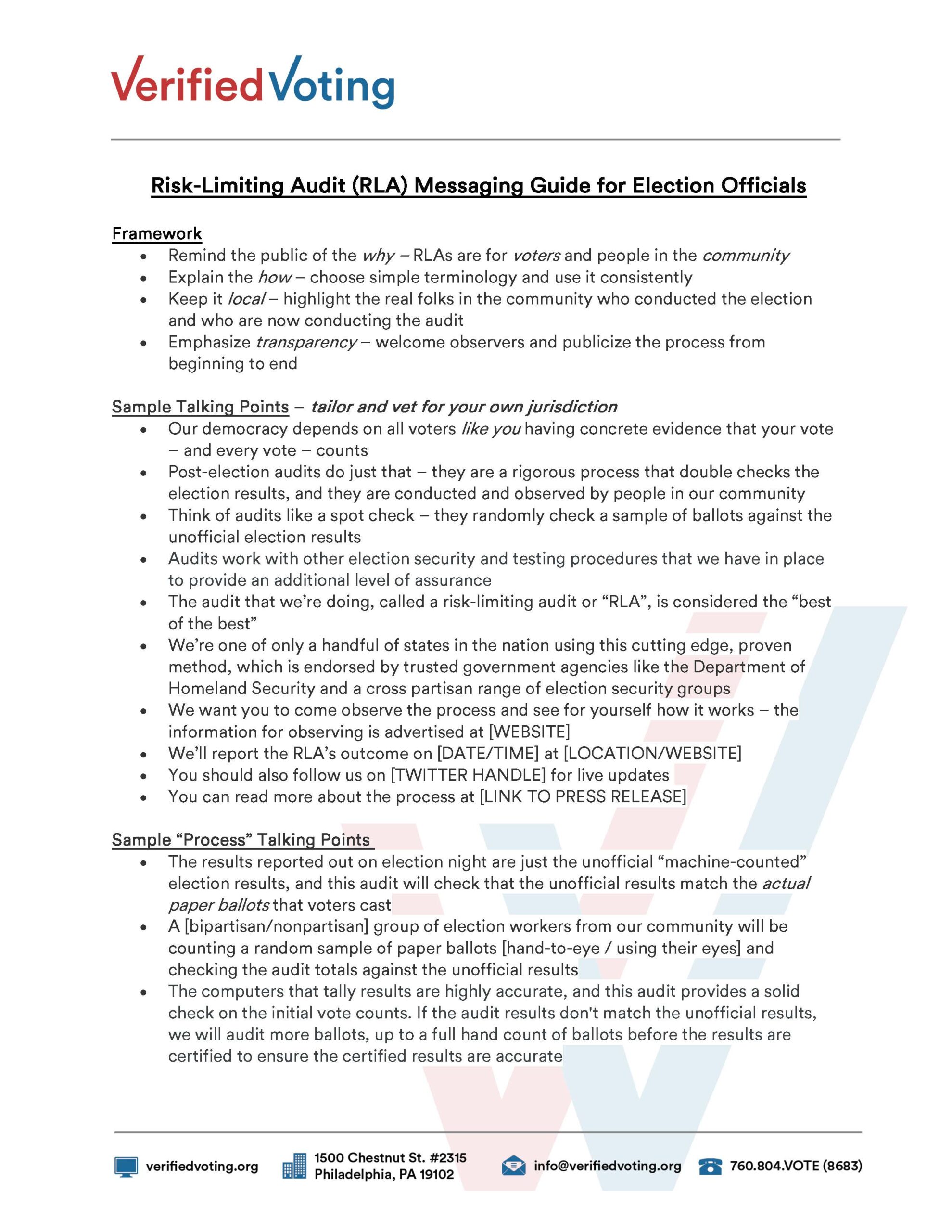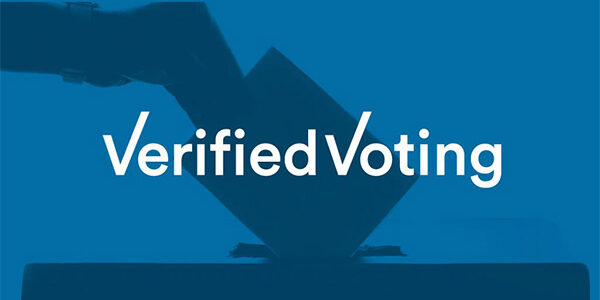
resource
Verified Voting's Risk-Limiting Audit Messaging Guide for Election Officials
Date: updated February 1, 2023
Author: Verified Voting
Issue: Post-Election Audit
Publication Summary
A messaging guide to help election officials talk to their constituents, the press, and other key stakeholders about risk-limiting audits.
Framework
- Remind the public of the why – RLAs are for voters and people in the community
- Explain the how – choose simple terminology and use it consistently
- Keep it local – highlight the real folks in the community who conducted the election and who are now conducting the audit
- Emphasize transparency – welcome observers and publicize the process from beginning to end
Sample Talking Points – tailor and vet for your own jurisdiction
- Our democracy depends on all voters like you having concrete evidence that your vote – and every vote – counts
- Post-election audits do just that – they are a rigorous process that double checks the election results, and they are conducted and observed by people in our community
- Think of audits like a spot check – they randomly check a sample of ballots against the unofficial election results
- Audits work with other election security and testing procedures that we have in place to provide an additional level of assurance
- The audit that we’re doing, called a risk-limiting audit or “RLA”, is considered the “best of the best”
- We’re one of only a handful of states in the nation using this cutting edge, proven method, which is endorsed by trusted government agencies like the Department of Homeland Security and a cross partisan range of election security groups
- We want you to come observe the process and see for yourself how it works – the information for observing is advertised at [WEBSITE]
- We’ll report the RLA’s outcome on [DATE/TIME] at [LOCATION/WEBSITE]
- You should also follow us on [TWITTER HANDLE] for live updates
- You can read more about the process at [LINK TO PRESS RELEASE]
Sample “Process” Talking Points
- The results reported out on election night are just the unofficial “machine-counted” election results, and this audit will check that the unofficial results match the actual paper ballots that voters cast
- A [bipartisan/nonpartisan] group of election workers from our community will be counting a random sample of paper ballots [hand-to-eye / using their eyes] and checking the audit totals against the unofficial results
- The computers that tally results are highly accurate, and this audit provides a solid check on the initial vote counts. If the audit results don’t match the unofficial results, we will audit more ballots, up to a full hand count of ballots before the results are certified to ensure the certified results are accurate
Quick Hits
- RLAs promote public confidence in election outcomes and public confidence in our democracy
- RLAs check that the winners won and the losers lost
- RLAs ensure the integrity of the election results
- RLAs provide solid evidence that the reported election outcomes are correct
- RLAs are transparent and observable by the public
- RLAs are cost-efficient and save taxpayer dollars
RLA Pilots
- RLA pilots are “test runs” that happen in election jurisdictions across the country that are not binding on the election outcome
- RLA pilots help election workers prepare for full RLAs in larger elections
- RLA pilots are also an opportunity for the elections office to communicate to constituents about the importance of post-election audits, including RLAs, and show that the processes are observable and transparent
Want a deeper dive? Here’s how RLAs differ from other audits:
- Unlike some procedures that simply rescan and retabulate ballots, RLAs examine paper ballots hand-to-eye to ensure that machine-tabulated results align with the paper ballots
- RLAs are designed to provide high assurance of correct election outcomes even in close contests
- An RLA can also trigger a full hand recount if the sampled ballots do not match the reported outcome
- RLAs allow jurisdictions to save time and resources by checking more ballots when needed in close contests, and fewer ballots in contests with wider margins
- Read more about how true audits like RLAs are different from sham reviews here
Terminology
- Tabulation audit – Provides a routine check on the accuracy of the tabulation of votes by manually comparing voter-verifiable paper ballots to the computer-reported results
- Risk limit – The “risk limit” describes the chance that the audit is wrong. For instance, a 5% risk limit means that if the election outcome is wrong, the chance that the audit will mistakenly confirm it is 5% or less. We usually avoid these specifics with a general audience
- Recount – A full recount means counting all of the ballots, while an audit only entails counting some of the ballots. Post-election audits that detect errors can lead to a full recount if the outcome is in doubt
- Sample size & margin of victory – Close contests, where the winner’s margin of victory is small, require looking at larger samples of ballots to check the outcome
Who Endorses RLAs – A Non-Exhaustive List
- U.S. Department of Homeland Security
- U.S. Senate Select Intelligence Committee
- Presidential Commission on Election Administration
- American Statistical Association
- R Street Institute
- League of Women Voters
For more information on risk-limiting audits, visit www.verifiedvoting.org/audits. For questions or feedback on messaging, contact Verified Voting Communications Officer Corrie Emerson at corrie@verifiedvoting.org.
Verified Voting RLA Messaging Guide 2023 by Verified Voting on Scribd
